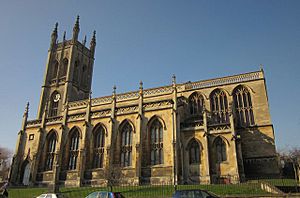St Saviour's Church, Bath facts for kids
Quick facts for kids St Saviour's Church |
|
|---|---|
 |
|
| 51°23′45″N 2°20′47″W / 51.3958°N 2.3465°W | |
| Country | United Kingdom |
| Denomination | Anglican |
| History | |
| Founder(s) | Charles Moysey |
| Consecrated | April 1832 |
| Architecture | |
| Heritage designation | Grade II* Listed |
| Designated | 12 June 1950 |
| Architectural type | Church |
| Style | Gothic Revival |
| Groundbreaking | 1829 |
| Completed | 1832 |
| Construction cost | £10,600 |
| Administration | |
| Deanery | Bath |
| Diocese | Bath and Wells |
| Province | Canterbury |
St Saviour's Church is a historic Church of England parish church located in Larkhall, a part of Bath, Somerset, England. It's a special building that has been around for nearly 200 years.
Contents
History of St Saviour's
How the Church Started
The idea for St Saviour's Church came from Archdeacon Charles Moysey in 1824. He wanted to build new churches to serve growing communities. This was part of a bigger plan across England, helped by the Church Building Act 1824. St Saviour's is one of three churches in Bath that were built with help from this plan. These churches are sometimes called "Commissioners' churches" because they received money from a special commission.
Building the Church
The construction of St Saviour's Church began in 1829 and was finished in 1832. It's believed that the architect John Pinch the younger designed the church, possibly using ideas from his father, John Pinch the elder. The church cost about £10,600 to build, which was a lot of money back then!
In 1882, the church was made bigger. An architect named C. E. Davis added a chancel, which is the part of the church near the altar where the choir usually sits.
Architectural Style
St Saviour's Church is built in the Gothic Revival style. This means it looks like older Gothic churches from the Middle Ages, with pointed arches and detailed stonework. When the church was officially recognized as a Grade II* listed building in 1950, experts noted its design. A Grade II* listing means the building is very important and has special historical or architectural interest. The church shows details from both the "Decorated" and "Perpendicular" periods of Gothic architecture.
The Church Crypt
Burials at St Saviour's
The church has a crypt underneath it, which was opened in 1832. A crypt is an underground room, often used for burials. The first person to be buried in the crypt was Rear-Admiral Volant Vashon Ballard in October 1832.
Over the years, more than 200 people were buried at St Saviour's Church. However, the burial grounds were closed in 1891. After that, people were buried at Locksbrook Cemetery until 1937.

